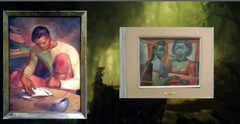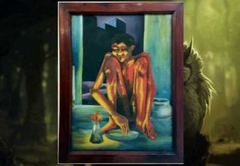![]()
![]()
![]()
Use LEFT and RIGHT arrow keys to navigate between flashcards;
Use UP and DOWN arrow keys to flip the card;
H to show hint;
A reads text to speech;
28 Cards in this Set
- Front
- Back
|
*Highest National Honor and Recognition *Contributed to the development and Promotion of Philippine Arts *Field of Music, Dance, Theater, Visual Arts, Literature, Film and Broadcast Arts, and Architecture or Allied Arts. *Ideals in Humanism and Artistic Expression |
The Order of the National Artist |
|
|
On Becoming A National Artist |
Orden ng mga Pambansang Alagad ng Sining. Presidential Proclamation No. 1001 April 27, 1972 KKK CCP-NCCA-ONAA (recommend, organize, plan and implement) Malacanang Palace Awarded by the Philippine President Based on the creativity, imagination, technical proficiency with the highest degree uniquely expressing Filipino Culture, traditions as well as their aspirations. |
|
|
As reiterated by the Commission, the Order of National Artists aims to recognize the following: |
Filipino Artist who have made significant contributions to the cultural heritage of the country. Filipino Artistic accomplishment at its highest level and to promote creative expression as significant to the development of a national identity. Filipino Artists who have dedicated their lives to their works to forge new paths and directions for future generations of Filipino Artists. |
|
|
depiction of fishing as a difficult process |
Magpupukot |
|
|
THE REWARDS OF BEING A NATIONAL ARTIST: |
The rank and title of National artist, as proclaimed by the President of the Philippines. The National Artist gold-plated medallion minted by the Bangko Sentral ng Pilipinas (BSP) and citation. Lifetime emolument, material and physical benefits such as minimum cash reward of 200, 000 pesos for living awardees. For Posthumous Awardees, 150, 000 pesos. Life insurance coverage for Awardees who are still insurable. State Funeral benefit not exceeding 500,000 pesos. A place of honor in state functions, national commemoration ceremonies and all other cultural presentations. |
|
|
CRITERIA FOR THE SELECTION OF THE NATIONAL ARTIST: |
1. Living artist are natural-born Filipino Citizens at the time of nominations, as well as those who died (1972). Filipinos who have lost and re-acquired Filipino Citizenship through dual citizenship status for at least 5 years. 2. Artist who through the content and form of their works have contributed in building Filipino sense of nationhood. 3. Artist who have pioneered in a mode of creative expression or style, thus, earning distinction and making an impact on succeeding generations of artists. 4. Artist who have created a substantial and significant body of works and or consistently displayed excellence in the practice of their art from thus enriching artistic expression or style. 5. Artist who enjoyed broad acceptance through prestigious national and/or international recognition; critical acclaim and or reviews of their works and finally respect and esteem from peers. |
|
|
THE PROCEDURE IN BEING NOMINATED AS A CANDIDATE FOR NATIONAL ARTIST |
Dance Music Theater Visual Arts Literature Film and Broadcast Arts Architecture, Design and Allied Art |
|
|
composition, direction and or performance |
Music |
|
|
direction, performance, and or production design |
Theater |
|
|
choreography, direction and or performance. |
Dance |
|
|
painting, sculpture, printmaking, photography, installation art, mixed media works, illustration, graphic arts, performance art and or imaging |
Visual Art |
|
|
poetry, fiction, essay, playwriting, journalism, and or literary criticism. |
Literature |
|
|
direction, writing, production design, cinematography, editing, camera work, and or performance. |
Film and Broadcast Arts |
|
|
architecture design, interior design, industrial art design, landscape architecture and fashion design. |
ARCHITECTURE, DESIGN and ALLIED ARTS |
|
|
The country had its first National Artist in Fernando C. Amorsolo. The official title “Grand Old Man of Philippine Art” was bestowed on Amorsolo when the Manila Hilton inaugurated its art center on January 23, 1969 with an exhibit of a selection of his works. Returning from his studies abroad in the 1920s, Amorsolo developed the backlighting technique that became his trademark where figures, a cluster of leaves, spill of hair, the swell of breast, are seen aglow on canvas. A product of the Art School of Liceo de Manila and University of the Philippines. |
FERNANDO AMORSOLO (1972) |
|
|
rendition emphasizes calm and placidity) |
Fishing Scene |
|
|
He was rewarded as the National Artist for Painting, considered as the greatest muralist of the country and 1964 Republic of the Philippines Cultural Heritage awardee. He is also part of the modern art movement, with Victorio C. Edades and Galo Ocampo that was known in local art circles as “the triumvirate”. In 1938, it was changed to “the thirteen moderns”, a group of modern artist. |
CARLOS BOTONG FRANCISCO (1973) |
|
|
In addition, Carlos was not just a mural painter but he is also a scriptwriter – of Genghis Khan, Putol na Kampilan and Tatlong Labuyo, and designed costumes for different films such as Romeo at Julieta, Prinsipe Tenoso, Ibong Adarna, Siete Infantes de Lara and Juan Tamad series. Fiesta Pavillion of the Manila Hotel Murals for the residences of prominent Filipinos The bayanihan scene for the Philippine Bank of Commerce The four-panel History of Medicine for the Philippine General Hospital The stations of the cross at the Far Eastern University chapel and the life of St. Dominic for the Sto. Domingo Church. Lastly, his major masterpiece was the mural that he did for the Bulwagang Katipunan of Manila City Hall. |
CARLOS BOTONG FRANCISCO (1973) |
|
|
Father of Modern Art in the Philippines" and named National Artist in 1976, was born in Dagupan, Pangasinan. However, viewers and critics of the Filipino art circle were apparently shocked by what he had learned abroad, and not one painting was sold. In 1930, Edades became dean of the Department of Architecture, University of Santos Tomas (UST), where he stayed for three full decades. he conducted a one-man exhibit in Ermita, showing what modern art was all about, with his 30 paintings, including those which won acclaim in America. His Builders is considered a masterpiece. |
Victorio Edades (1895) |
|
|
Shows oppressive condition of the underprivileged classes. |
The Builders |
|
|
Is a Filipino National Artist in painting. He was also an art director prior to going full-time in his visual art practice in the 1960s. His early (1940s-1960s) works are described as depictions of anguish and dehumanization of beggars and laborers in the city. These include Man and Woman (alternatively known as Beggars) and Gadgets’. Primarily because of this early period, critics have further cited Legaspi’s having “reconstituted” in his paintings “cubism’s unfeeling, geometric ordering of figures into a social expressionism rendered by interacting forms filled with rhythmic movement”. |
Cesar Legaspi (1990) |
|

|
The Frugal Man |
|
|
Leading modernist artist in the Philippines. One of the Thirteen Moderns, as well as the Neo-Realists and the Saturday Group of Artists, he is known for his unique approach to abstraction inspired by Philippine flora and fauna, fantasy and science fiction. His most recognized work 'Genesis' was the basis of the curtain of the Main Theater of the Cultural Center of the Philippines. He is the recipient of several awards including the Republic Cultural Award in 1965; Patnubay ng Sining at Kalinangan Award in 1969; Diwa ng Lahi Award in 1976; and Gawad CCP para sa Sining Award in 1979; and the National Artist for the Visual Arts in 1999. |
Hernando Ruiz Ocampo(1991) |
|
|
in Caloocan stands as an enduring symbol of the Filipinos’ cry for freedom. |
The Bonifacio Monument |
|
|
His family perform their life as their art and vice versa, as evident in the art spaces in Baguio which have become associated with a mix of performance, installation, architecture, and culinary arts. It is hard to separate the artist from his space of practice and his lifework. However, the output is not his alone. The process is collaborative, and the experience is immersive and interactive, such that the art is never complete without the audience’s active input. |
KIDLAT TAHIMIK |
|

|
The Poor and Ordinary people on the streets |
|
|
He is a product of the Revival period in Philippine art. Returning from Europe (where he was enrolled at the Royal Academy of Fine Arts, Rome) in 1925. He was appointed as professor at the UP School of Fine Arts where the idea also of executing a monument for national heroes struck him. He also designed the gold and bronze medals for the Ramon Magsaysay Award and did the seal of the Republic of the Philippines. Works: UP Oblation, President Quezon at Quezon Memorial, Jose Rizal and Ramon Magsaysay |
GUILLERMO TOLENTINO (1973) |
|
|
The newly declared National Artists are: Visual Arts Theatre and Literature Music Film and Broadcast Art Architecture and Allied Art Literature Literature |
Larry Alcala Amelia Lapeña-Bonifacio Ryan Cayabyab Kidlat Tahimik Francisco T. Mañosa Resil B. Mojares Ramon Muzones |

